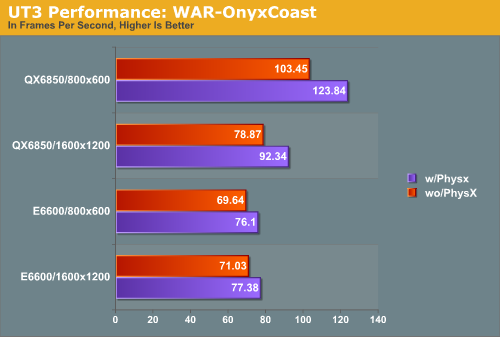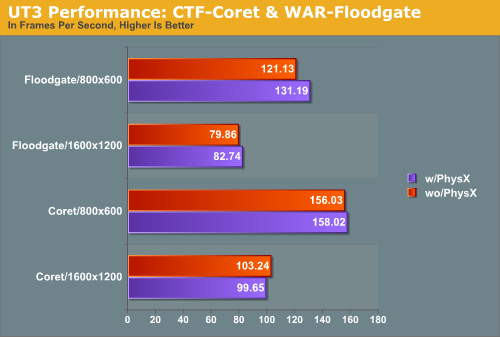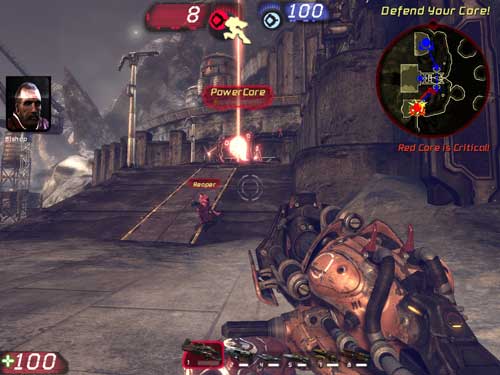PhysX’s Big Break? Unreal Tournament 3 PhysX Performance
by Ryan Smith on December 14, 2007 12:00 AM EST- Posted in
- GPUs
PhysX Performance Under UT3: Stock Maps
Moving on to performance with the stock UT3 maps, these do not involve any first-order physics to the best of our knowledge. However it’s still entirely possible to improve on second-order performance.

When we were originally benchmarking for this article, we started and intended to finish with WAR-OnyxCoast, an arctic-themed Warfare mode map that offers the full gamut of UT3 weapons and vehicles. What we found surprised us, so much in fact that we didn’t originally believe the results had we not been the ones doing benchmarking ourselves.
Against our initial expectations, WAR-OnyxCoast shows a performance improvement with the PhysX PPU installed, even with the light physics work being done. This is most obvious with our QX6850, where performance increases a respectable 15-20%. We ran this test several times more than the rest of our tests just to make sure this wasn’t a fluke or a product of botmatch variations and it’s not, there’s a definite performance improvement.
What’s driving this performance improvement we can only hypothesize on, compared to the more muted improvements with our E6600. Our best guess is that we’re CPU limited with the slower processor, with the limiting process being something other than physics (possibly bot AI), whereas that limit lifts with a faster processor. Of course we’d expect with more processing power the CPU would have no trouble keeping up with the PhysX PPU, but this doesn’t appear to be the case. It’s possible we’re still CPU and GPU limited on this map (explaining the change from 1600x1200 to 800x600), but we’re going to have to settle with the fact that we have a mystery on our hands for now.
Based on our results with WAR-OnyxCoast, we’ve also benchmarked CTF-Coret and WAR-Floodgate, to see if we can repeat those performance improvements, this time only with our QX6850.

Unlike WAR-OnyxCoast, neither of these maps showcases a large enough performance improvement with the PhysX hardware to positively confirm our earlier results. WAR-Floodgate is most like WAR-OnyxCoast out of these two additional maps, so it’s not particularly surprising that it peaks with an 8% performance improvement, but this is very close to the threshold for botmatch-induced variability, so it’s not conclusive. Meanwhile CTF-Coret flips between gaining and losing a marginal amount of performance, so we can be sure that it’s acting entirely within our experimental variability.
Looking at all of our results then, is the PhysX PPU improving performance under UT3’s stock maps? Probably. We can’t rule out other possibilities with the data we have, but our best explanation is that given a big enough map with enough players and vehicles, and enough of a computer to not be held down elsewhere, the PhysX PPU is giving us a measurable performance improvement of 10-20%. However we also have to keep in mind that with the frame rates we were already getting and the kinds of maps we believe this benefit is most pronounced on, that it’s not making a significant difference.











29 Comments
View All Comments
marbles - Saturday, December 22, 2007 - link
We represent a very small fraction of PC gamers and users and even many of us are not sure we'll ever buy a PPU card. From someone who has repaired and built PCs over the years and has spent hours explaining the difference between "free" onboard graphics and 700.00 graphics cards I don't want to have to explain a PPU.Look at the Geo mod capability in Red Faction (7 yrs ago) and the physics incorporated into the Source engine (3 yrs ago). They all came "free" because of the willingness of the game maker to make this work and keep the game playable on a reasonable PC. Look at Fracture out next year for the PPU-less 360 and PS3.
The quality of popular PC franchises are already being compromised for consoles so there is little hope that a PC specific PPU will ever be required to play any game. I think AGEIA's best hope for the PC is middleware and having their technology integrated into main boards or graphic cards.
Are these two UT3 maps available for the consoles?
perzy - Wednesday, December 19, 2007 - link
The CPU is dead! The future is dicrete processors.The heat wall is a not a bump in the road, it IS a wall.
Look at chipzilla that had a concussion rammin it's head in the wall, spent 4-5 years redesigning then pentium m to core 2 duo.
AMD bought a gpu-manufacturer that still has a few years of developing before the heat wall and Intel bought Havok and is quietly gearing up it's own dicrete gpu-dept.
Nvidia seems to be working on worlddomination on their own, or just trying to boost their own value before being bought by chipzilla.
Sure you can have maybe 16 cores (heatwall + power envelope) on a CPU but still they are slow and they dont have their own superfast dedicated ram.
So Ageia is right on the mark, how far they now seem to be from it.
0roo0roo - Sunday, December 16, 2007 - link
give me all the physics you can on a 2 or 4 core cpu and go on from there. a phyx card does nothing during normal use. its dead weight. i'd rather pay for a nicer cpu or gpu which are used in some way 100% of the time. there just isn't a killer game play app for the ppu. stacking boxes is already possible and not that compelling. developing a ppu only killer app game isn't really something i can see happening. while they wait for that miracle to come by cpus will creep up and surpass the card anyways:PFrancisbacon - Monday, December 24, 2007 - link
You're absolutely correct.Games developers will only take PPUs seriously once a lot of people have them, and this will only be the case once Nvidia and ATI start shipping graphics cards with PPUs on-board.
This is not too far off, Nvidia and ATI are both known to be working on including physics on their next generation of cards.
Buying a bodge-job like this, a PCI expansion card which actually offers very little in the way of power and only really affects one mainstream game in a very minor way is a total waste of money right now. It's far more sensible to upgrade your CPU and wait for physics-enabled graphics cards to come out.
On top of all this, I'm fairly certain exactly the same results could have been acheived by fully utilising all four cores of the CPU, but the Ageia modders chose not to, for obvious reasons.
Francisbacon - Monday, December 24, 2007 - link
You're absolutely correct.Games developers will only take PPUs seriously once a lot of people have them, and this will only be the case once Nvidia and ATI start shipping graphics cards with PPUs on-board.
This is not too far off, Nvidia and ATI are both known to be working on including physics on their next generation of cards.
Buying a bodge-job like this, a PCI expansion card which actually offers very little in the way of power and only really affects one mainstream game in a very minor way is a total waste of money right now. It's far more sensible to upgrade your CPU and wait for physics-enabled graphics cards to come out.
On top of all this, I'm fairly certain exactly the same results could have been acheived by fully utilising all four cores of the CPU, but the Ageia modders chose not to, for obvious reasons.
Sacher - Sunday, December 16, 2007 - link
Nice in-depth article. I'm wondering, what did you (Ryan) have the texture-detail and world-detail [advanced video] settings at?Does the physics load change when using different world-detail settings?
FITCamaro - Friday, December 14, 2007 - link
While performance didn't increase that much with the PPU on the real maps, did the game look better? You didn't answer this. If I get noticeable better effects with the PPU and the same performance as without, thats a win to me. If it just displays the same effects as without the PPU just faster, then no its not worth it.Physics is not about increasing the FPS of a game. It's about making it more realistic and immersive.
Ryan Smith - Friday, December 14, 2007 - link
We mentioned this elsewhere in the article, but the effects are the same. Enabling the PhysX hardware only offloads them to the PPU, it doesn't create any new effects.ET - Friday, December 14, 2007 - link
For a low end or old system, an inexpensive card which could offer a performance boost would have been welcome. However these tests show more of a performance gain on the quad core than the dual core. While this might mean that people with money to spare (high end quad core users) may be able to get even more performance for relatively little (compared to their CPU's price), low end buyers can't get as much of a boost.Which sounds to me backwards. If I could get a significant performance boost for my semi-old PC, I might have been more interested.
SuperGee - Sunday, December 16, 2007 - link
That is because a lowbudged game rig has several bottlenecks and if this is GPU holding back FPS, ofloading a not so bottlenck like CPU yields not much in such case.As most game tend to be GPU limited. And a old or low budged PC wil often be most limited on GPU.
A PPU isn't ment for offloading but for more Physics. This means a decent game-rig is needed to use a PPU properly with a physics load made for PPU.
A PPU is more ment for Physics enthausiast, early adopter, hardcore gamers or highbudged rigs. To play PhysX games in optimal settings.
The QC yield so much because the benched it with a less GPU stressing setting. Wich is not the way people game with a high-end game PC.